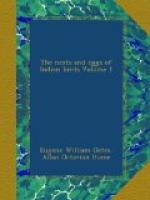522. Oriolus traillii (Vigors). The Maroon Oriole.
Oriolus traillii (Vig.), Jerd. B. Ind. ii, p. 112; Hume, cat. no. 474.
From Sikhim Mr. Gammie writes:—“I took a nest of this Oriole on the 24th April, at an elevation of about 2500 feet. It was suspended, within ten feet of the ground, from an outer fork of a branch of a small leafy tree, which grew in a patch of low dense jangle. It is a neat cup, composed of fibrous bark and strips of the outer part of dry grass-stems, intermixed with skeletonized leaves and green moss, and lined with fine grass. Besides being firmly bound by the rim of the cup to the horizontal forking branches by fibrous barks, several strings extended from one branch to the other, both under and in front of the nest, while other strings from the body of the nest were fastened to an upright twig that rose immediately behind the fork, thus most securely retaining it in its position.
“Externally the nest measured 5 inches wide by 2.75 in height; internally 3.25 wide by 2 deep. It contained three fresh eggs.
“The female came quite close, making loud complaints against the robbing of her nest.”
The nest is that of a typical Oriole, usually very firmly and substantially built, and of course always suspended at a fork between two twigs. A nest taken by Mr. Gammie in Sikhim on the 20th April, at an elevation of about 2500 feet, is a deep substantial cup, nearly 4 inches in diameter and 21/2 in depth internally. It is everywhere nearly an inch in thickness. The suspensory portion composed of vegetable fibres; towards the exterior dead leaves, bamboo-sheaths, green moss, and tendrils of creeping plants are profusely intermingled; interiorly, it is closely and regularly lined with very fine grass.
A nest sent me by Mr. Mandelli was found on the 3rd April at Namtchu, and contained three fresh eggs. It is precisely similar to the one above described, except that in the lining roots are mingled with the fine grass, and that instead of being suspended in a fork, it was partly wedged into and partly rested on a fork.
As a rule, however, as I know from other nests subsequently obtained, the nests are always suspended like those of the Common Oriole.
Two eggs of this species obtained by Mr. Gammie closely resemble those of O. melanocephalus. In shape they are regular moderately elongated ovals; the shell is strong, firm, and moderately glossy. The ground is white with a creamy or brownish-pink tinge; the markings are blackish-brown spots and specks, almost confined to a zone about the large end, where they are all more or less enveloped in a brownish-red haze or nimbus. In length they measure 1.12 by 0.82, and 1.14 by 0.83.
Family EULABETIDAE
523. Eulabes religiosa (Linn.). Jerd. B. Southern Grackle.
Eulabes religiosa (Linn.), Jerd. B. Ind. ii, p. 337; Hume, Rough Draft N. & E. no. 692.




